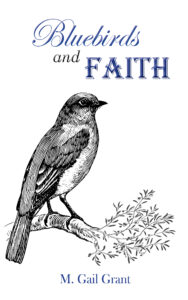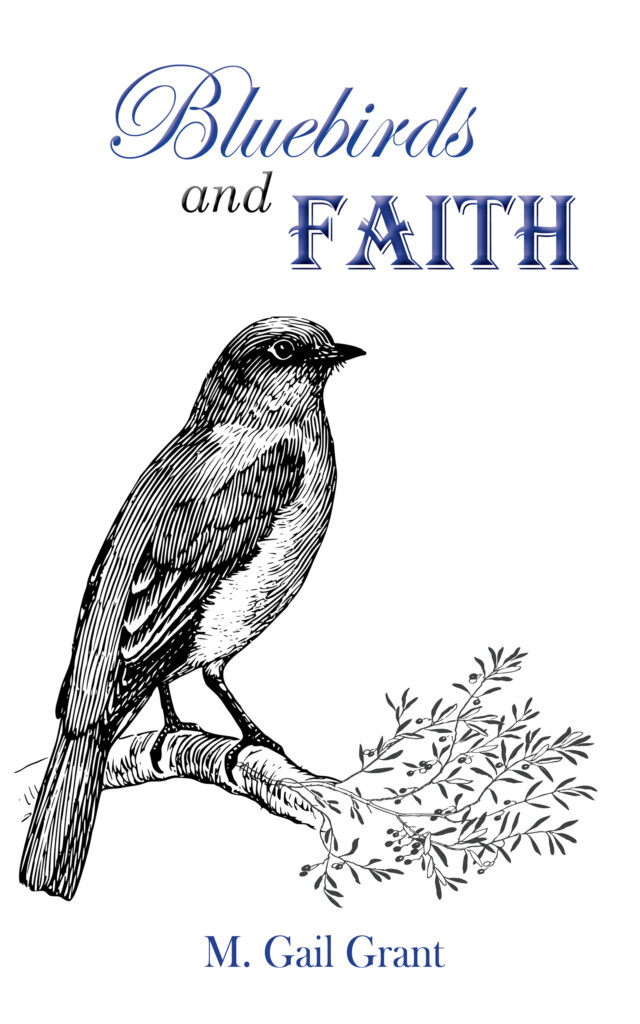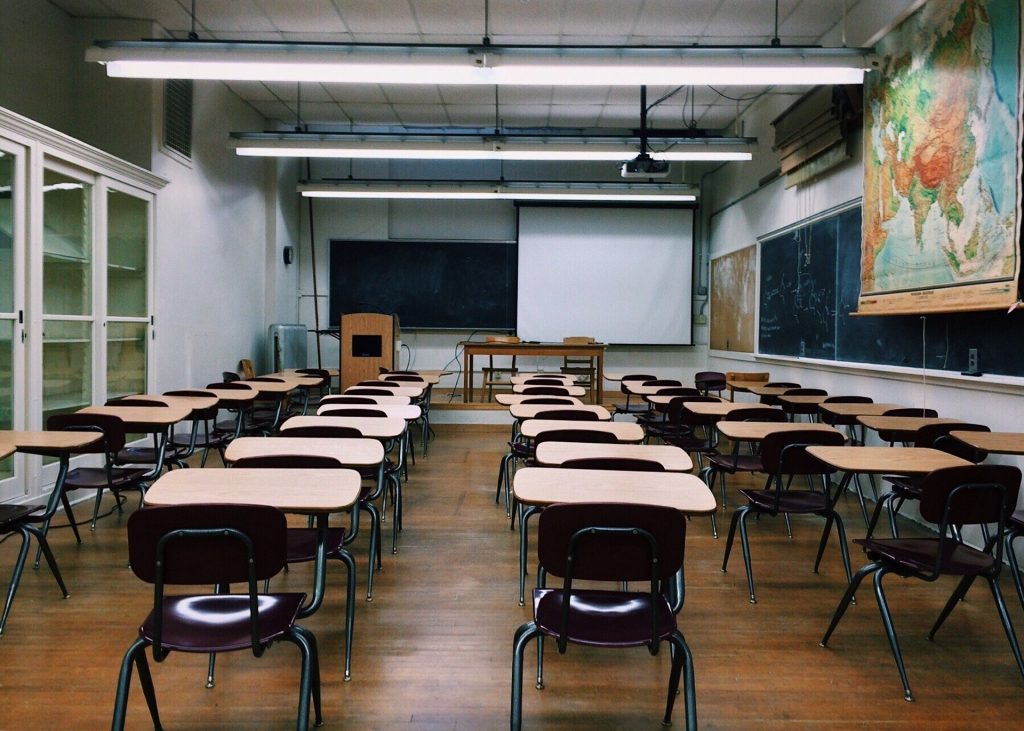-
Net Galley!

Bluebirds and Faith is now available for review on Net Galley! See the link below for access.
-
New Release!

Bluebirds and Faith is a poetry collection that celebrates God’s gift of eternal grace by finding joy, humility, and comfort in our surroundings. Inspired by the death of a beloved father, Grant shares her journey of sorrow and healing in a world that seems so incredibly far away from heaven. Finding mercy in the wings of a bluebird, Grant discovers that the separation between heaven and earth may not be as vast as we think. Poetry, one of the world’s most treasured artistic expressions, is the vessel used to explore faith in a world stricken with fear and sin. Free verse and Haiku poetic forms are spread heavily throughout. Grant hopes sharing her spiritual evolution will bring solace and peace to others at a time in their life when they feel no one else is listening. He always listens. God bless.
-
Book Giveaways
Goodreads Book Giveaway
Enter GiveawayMagdalena Gottschalk
by M. Gail Grant
Giveaway ends September 24, 2020.
See the giveaway details at Goodreads.
-
FYC Classrooms in the Digital Age

Writing across multiple modes . . . Multimodality — it is a buzz word that tends to bring forth mixed emotions for both professors and students alike. Technology seems to be here to stay, and with the emergence of digital media platforms (social media, eBooks, blogs, and digital learning structures), it has become increasingly more imperative for English composition instructors to expose students to the conventions of writing in these types of mediums. As an incoming English composition teacher, I consider it my duty to prepare students for writing across the curriculum, as well as for life beyond the walls of an academic institution. In previous blog posts, I have thoroughly discussed my intention of structuring the course as a methods-process based design in lieu of product-based only. However, as Alexander Reid explains, “Some writing instructors view emerging technologies with great enthusiasm; others view them as a threat” (185).
Being from a pre-technological advancement era, I understand the apprehension in embracing multimedia components in a college-level classroom focused on writing. With only sixteen weeks per semester and classes that last only fifty minutes three times a week, there is so much to be covered. The question becomes, how do I effectively teach students grammar instruction, writing instruction, composition theory (so they understand the why behind what they are being asked to do), as well as how to write for multiple audiences not only within varying genres but also across numerous modes of publications/platforms?

How to introduce writing across multiple mediums? The question is actually quite daunting, and while I find myself in this very scenario, I try to remain focused on Reid’s perspective, “Writers write. A course that takes as its objective the development of writers must begin and end with writing as an activity, and the amount of writing that students do should not be limited by the instructor’s ability to respond to the writing” (187). Bingo! My takeaway is this — just keep students writing! Regardless of the platform used, genre, or audience targeted, all writing and assignments do not need to be instructor graded. Since writers write, what better way to continuously support the course objectives and learning outcomes than to consistently provide students the opportunity to . . . JUST WRITE!

Just Write! Keeping the concept of “writing” in mind, while attempting to continuously expose students to multimodal writing, I have begun to design unit four of my English 1101 course design. The final project/essay will incorporate light research and multimodality. Students will research a topic (still working on the exact nature and/or origin of the topic) and compose an annotated bibliography to organize their research and prepare for English 1102 (the second course of the one-year sequence). Students will be expected to write a summary/analysis of research that will be relatively short, approximately 2-3 pages plus works cited page.
Next, students will utilize the same research information from the essay and create a multimodal project.
Examples of multimodal mediums that may be incorporated into the final product are blog posts, brochures, webpages, and PowerPoint presentations.

Multimodal Writing . . . The purpose of the assignment is to teach students first-hand how writing can be adapted not only across various genres but also across varying mediums. Technology is here to stay, and finding a way to incorporate said technology in composition classrooms will only strengthen students’ confidence in the art of writing, as well as provide real-world examples of why the concepts taught in English composition are of vital importance to life outside of academia.
Works Cited
Altmann, Gerd. Pixabay, 2020, pixabay.com/illustrations/light-bulb-think-idea-solution-2010022/.
Altmann, Gerd. Pixabay, 2020, pixabay.com/illustrations/interaction-social-media-abstract-1233873/.
Pexels. Pixabay, 2020, pixabay.com/photos/adult-diary-journal-notebook-book-1850177/.
Reid, Alexander. “The Activity of Writing: Affinity and Affect in Composition.” First-Year Composition: From Theory to Practice, edited by Coxwell-Teague, Deborah and Ronald F. Lunsford, Parlor Press, 2014, pp. 184-210.
Tumisu. Pixabay, 2020, pixabay.com/illustrations/blog-blogging-blogger-computer-492184/.
-
Rhetorical Grammar: The FYC Classroom

The art of written rhetoric . . . In Making a Case for Rhetorical Grammar, Laura R. Micciche introduces a very persuasive argument in support of teaching rhetorical grammar in composition classrooms. Micciche surmises, “The study of rhetorical grammar can demonstrate to students that language does purposeful, consequential work in the world — work that can be learned and applied” (716). Furthermore, Micciche elaborates, “We need a discourse about grammar that does not retreat from the realities we face in the classroom — a discourse that takes seriously the connection between writing and thinking, the interwoven relationship between what we say and how we say it” (718).
I must admit, I agree wholeheartedly with Micciche. By teaching students to edit and ‘polish’ their grammar in the final drafts of essays and written assignments, we are teaching them that grammar does not have a function in eliciting desired reactions (utilizing rhetorical appeals in persuasive arguments). Instead, we are teaching students that grammatical editing simply changes sentence structure and punctuation to conform to the prescriptive style of writing. As a tutor in the Kennesaw State University’s writing center, I can say from personal experience, this often translates to students being primarily concerned with comma usage and how to avoid the infamous comma splice. However, there is so much more to be discovered in the underlying premise of understanding and utilizing grammatical choices in writing.

Rhetorical choices in composition . . . Micciche references the book, Rhetorical Grammar, authored by Martha Kolln and Loretta Gray, as a resource. Last semester, one of the courses I took in the professional writing graduate program required Rhetorical Grammar as one of the textbooks. This book changed my life as a writer — literally. For some reason, I had to make it all the way to graduate school to identify a resource that not only provided a concise work about all things grammar-related, but it explains rhetorical choices through the usage of grammar as a way of achieving a writer’s desired results. Micciche further argues, “I am talking about rhetorical grammar as an integral component of critical writing, writing that at minimum seeks to produce new knowledge and critique stale thinking” (721).

Designing an English composition classroom . . . Each professor must individually decide the role rhetorical grammar will play in their classroom. For me, concepts found in both Rhetorical Grammar, and a book written by Gerald Graff and Cathy Birkenstein, They Say/I Say, which provides specific templates that employ rhetorical effects of written expression, will be integrated weekly into my course design. Specifically, each week I plan to set aside ten to fifteen minutes in class to discuss various topics found throughout these two textbooks. By providing my students with concrete examples of how the writing templates may be used or providing my students examples of how applying rhetorical grammar choices in the early composition phases of writing, will only enhance the readers’ experiences.
One specific example that I can offer from personal experience is what Rhetorical Grammar coins the ‘known-new contract’. A common concern I have witnessed from student feedback and inquiry is whether the essay or connecting paragraphs ‘flow’. The only guidance I ever received on this topic was to make sure the first sentence in a joining paragraph linked to the idea presented in the previous paragraph. Believe me, I agree with students, there is much more that needs to be explained when it comes to creating paragraphs and essays that take the reader through a seamless series of events — enter Rhetorical Grammar and the ‘known-new contract’. The concept teaches the first part of a sentence should be the ‘known’ information found in the preceding sentence. The latter part of the sentence should be the now ‘new’ information, and so it proceeds moving forward. This constant stream of known to new presentation gives the reader a sense of cohesiveness.

Writing for success . . . The lack of cohesiveness and effectiveness of rhetorical appeal found in composition writing can be directly impacted by the inclusion of grammatical “strategy” in the course. Yes, it takes up time in an already limited space. Yes, some students may approach it as ‘boring’. Yes, it is my duty as a professor of English composition to ‘teach’ my students ways that enhance their writing. An analogy I like to give is, “The more tools you have in your toolbox, the better.” My hope is that providing short excerpts of rhetorical grammar theory and implication into my English 1101 classroom will ultimately provide students with a new way of approaching the WRITING PROCESS. Again, my class will be process-oriented and not product-oriented. Yes, the product must manifest; however, I am more concerned with students learning to identify with writing as a process that works across the curriculum and across their professional careers outside of academia. Learning how to make rhetorical choices and not just ‘polish’ and ‘fix commas’ will lead to much greater success in the usage of rhetoric in writing.
Works Cited
Altmann, Gerd. Pixabay, 2020. pixabay.com/illustrations/business-idea-growth-business-idea-3189797/.
Falco. Pixabay, 2020. pixabay.com/photos/hildesheim-germany-lower-saxony-711009/.
Graff, Gerald, and Cathy Birkenstein. They Say / I Say: The Moves That Matter in Academic Writing. Fourth edition., W.W. Norton & Company, 2018.
Hahilove. Pixabay, 2020. pixabay.com/illustrations/light-bulb-ideas-sketch-i-think-487859/.
Kolln, Martha, J., and Loretta S. Gray. Rhetorical Grammar: Grammatical Choices, Rhetorical Effects. Eighth edition, Pearson, 2016.
Micciche, Laura R. “Making a Case for Rhetorical Grammar.” College Composition and Communication, vol. 55, no. 4, 2004, p. 716. EBSCOhost, doi:10.2307/4140668.
Wokandapix. Pixabay, 2020. pixabay.com/photos/classroom-school-education-learning-2093743/.


